This incredible little flightless bird is quite an amazing animal, they are part of the Parrot family though have very little in common with the Parrots you are likely accustomed too, they are a prime example of the strange pathways evolution can take in differing environments.
Their numbers are however teetering on the brink of extinction and they are sadly an animal that belongs to this series, with less than 200 individuals they are an animal that may very go extinct before people have even heard of them.

Description
The reason for the Kakapos inability to fly is directly attributed to their evolution, throughout their evolution they have developed shorter wings and do not have a Keel on their Breastbone, the Keel is present on all flying birds as it allows the muscles required for flight to have an anchor-point.
The reason for the Kakapos evolutionary path to life on the ground likely resides in the fact that prior to the Human inhabitation of New Zealand, the islands were free from ground-dwelling carnivorous Mammals, this meant that the Kakapo, as well as other Bird species such as the Kiwi and Moa had no real need for flight, as such many Avian species endemic to New Zealand have no ability to fly.
The Kakapos plumage is predominantly green with blotched patches of yellow, they also have tactile feathers around their facial disk, a trait most commonly seen in Mammals in the form of Whiskers, they possess a large grey beak and have relatively small eyes for their body-size.
In truth, Kakapos share very few traits with their flying ancestors, their evolutionary journey likely began roughly 100 million years ago when the island of New Zealand was part of a larger landmass known as Gwanaland, once isolated the Kakapo evolved in a very different manner to its distant ancestors though they do still share a couple of traits that define them as Parrots with them having a curved Beak, as well as being Zygodactyls, a trait observed in all Parrots that means they have four toes per claw, with two toes pointing forward and two pointing back.
Aside from these basic traits the Kakapo is an oddity, it is not only the worlds heaviest parrot, it is also the worlds only flightless parrot, the only truly nocturnal parrot and is the only Parrot that utilises a Polygynous Lek breeding system whereby the male has no parental care. Other rare traits include their completely herbivorous diet, their sexually dimorphic appearance, and their lower metabolic rate which allows them to live for up to 90 years of age, significantly older than most Parrots, due to their isolation it is quite likely they are one of the oldest species of bird on the planet.
Diet & Habitat
The Kakapos diet is made up entirely of vegetation, fruit, nuts and seeds, their beak is adapted to grind food finely, as such they have the smallest Gizzard of any bird in relation to their size. Whilst they observably feast on a variety of 20-30 different plants, they have a seasonal taste for the fruit from the Rimu tree and during seasons of abundance will almost exclusively eat this fruit. They are relatively sedentary feeders and will not travel far in search of food, generally only feeding within an area no larger than 10x10 metres.
Whilst they were once present throughout New Zealand they are now entirely extinct on the main island, they can be found on only three islands which are:
- Codfish Island (Whenua Hou)
- Little Barrier Island (Hauturu o Toi)
- Anchor Island
These Islands are perfect habitats for the Kakapo as they are free from human encroachment and have no carnivorous species of Mammal present.
Behaviour & Reproduction
If you were to visit a Kakapo in the wild you would likely see them high up in the trees and you may be tricked in to believing that they can indeed fly, this is not the case and instead the Kakapo can climb near vertical rough surfaces, what they lack in flying ability they make up for in climbing skills. They are however one of the few flightless birds that partake in “parachute” jumps, they leap from tall areas and spread their short wings, this reduces their fall speed and can result in them "gliding" at a 45 degree angle for several meters, it’s not elegant, but it is effective.
The breeding season begins during the Southern Hemispheres warmer months from October to February, when the season begins male Kakapo will gather in an area referred to as a “breeding arena”, within this arena they will compete against each other to win the rite to breed with the females. The males will travel far and wide, often to distances of around 7km from their regular territory, once the males have established a courting location they will proceed to fight and defend the location from other males, which can result in severe injury and sometimes may result in death.
The Males will make a low frequency noise that they generate by inflating a Thoracic sac, they will generally repeat this low noise up to 20 times before swapping to a higher frequency sound which can be heard by females up to 1 km away, the male will repeat this sequence for up to 8 hours per night, this allows females enough time to locate and make a decision, should they be impressed by his displays.
Once attracted, the female will enter the males court where he will display by dancing and clicking his beak, should the female be impressed she will remain within the court, the male will then turn his back, spread his wings and proceed to walk backwards towards the female, if she is impressed she will then allow the male to breed with her, she will then return to her home territory and the male will continue to try to attract more females, he will continue this throughout the entire breeding season and will never aid in the upbringing of the chicks.
The female Kakapo will lay 1-2 eggs per breeding season, as her partner is absent she has full responsibility for their care, this means the eggs are susceptible to predation as the female still must leave the nest at night time to feed, during periods of cold weather this may result in the embryos within the eggs dying. The eggs must be incubated for a period of 30 days and once hatched the chicks are entirely reliant on their mother’s care, they will require her aid for three months before they are able to leave the nest and feed for themselves, they may however stay within her proximity for up to six months.
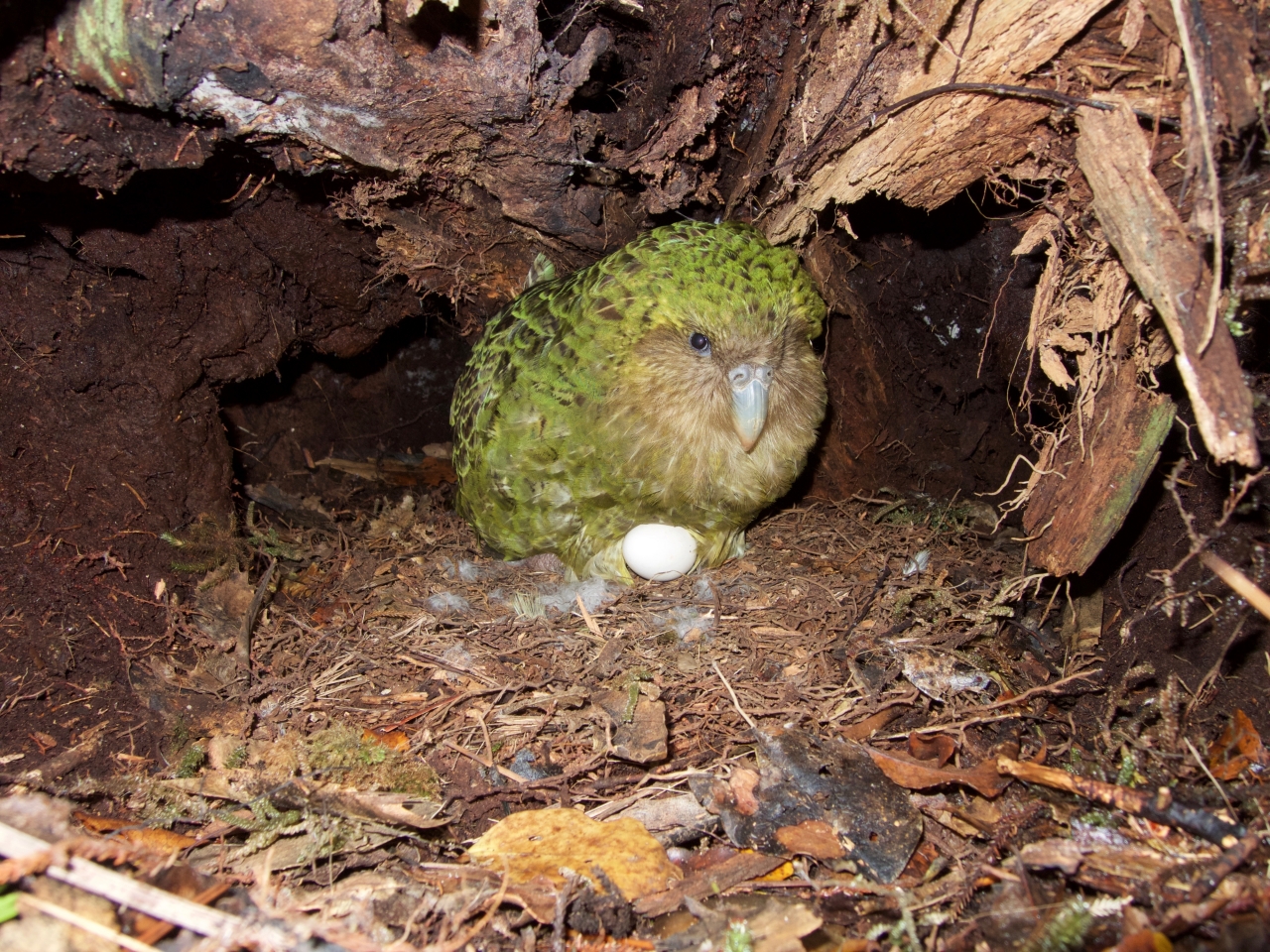
Male Kakapos reach sexual maturity at the age of 5 and females at the age of 9 and will breed once every 2-3 years, the average life expectancy is 58 years, but some individuals may live up to 90 years of age, this prolonged lifespan will yield many breeding cycles and is likely the reason for the Birds abundance prior to our arrival to the Islands.
Threats to the Kakapo
In 2016, it was recorded that there are now only 126 individuals, that includes 109 breeding adults left on the planet now classified by the IUCN Red List as Critically Endangered. This little species only survives in a very small population pools on three offshore islands. For a long time, they had no natural predators until humans inhabited the islands bringing mammals such as ferrets, cats, stoats, rats and dogs. The Polynesian people also assisted in decimating the population through hunting and destroying the forests the birds lived in.
On the Steward Island, it found that 50% of the adults were killed each year by cats, with stoats and black rats contributing to their rapid decline posing threats to eggs and chicks. The IUCN recognises that the birds have an abnormally low egg fertility and a low natural reproductive rate that are causing major concerns for the species. In 2004, three young birds died of Septicaemia that had not been reported within the species before and since 2002, 15 Kakapo have been diagnosed with Cloacitis on both Whenua Hou/ Codfish Island. This condition causes the Cloaca and lower digestive system to become infected and inflamed rendering the bird unable to breed, carrying a significant impact on this already Critically Endangered bird.Conservation Strategy to save the Kakapo
The Kakapo is a legally protected species in New Zealand and is listed on CITES Appendix I banning all trade of specimens worldwide. Since 1977, a small team of amazing people have given up all their time to protect, manage and increase the Kakapo population. Through the breeding season, they are hugely supported throughout New Zealand and through over-seas researchers who provide added support, nest minding and supplementary feeding.
In 2006, all invasive species to the three islands have now been eradicated allowing the recovery of the species to increase, with the staff working all year round to ensure the birds are safe, healthy and well fed. During the breeding season, each nest is monitored using infrared video cameras and remote proximity sensors that are allowing for researchers to understand how the birds raise their chicks, in turn perfecting the hand rearing methods that can be used in captive specimens.
The aim of the Kakapo Recovery program is to establish two well managed populations of the bird and create another self-sustaining population with at least 50 breeding females within a protected habitat. The team regularly removes eggs and chicks from the nest to artificially incubate and raise the chicks through an intensive process, requiring round the clock care by the staff that mimics the same conditions of a natural nest. After intensive research, the staff are able to successfully raise the chicks, of which, 69 have been raised and returned to the wild with a huge survival rate of 91% comprising 41% of the total Kakapo Population. In 2016, 16 hand reared females nested and successfully fledged 10 healthy chicks, of these 10 were first time mothers adding further success to this little bird.
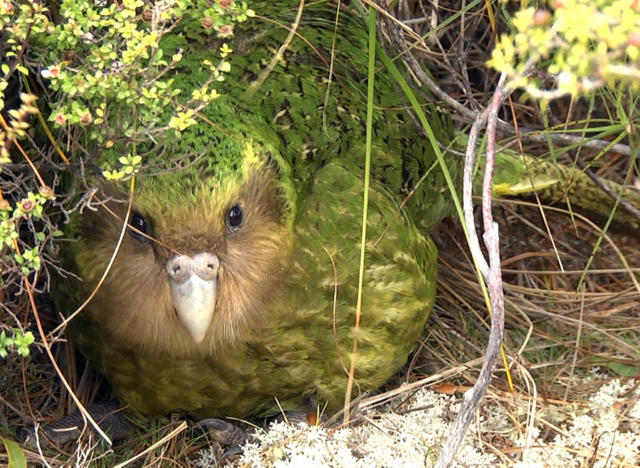
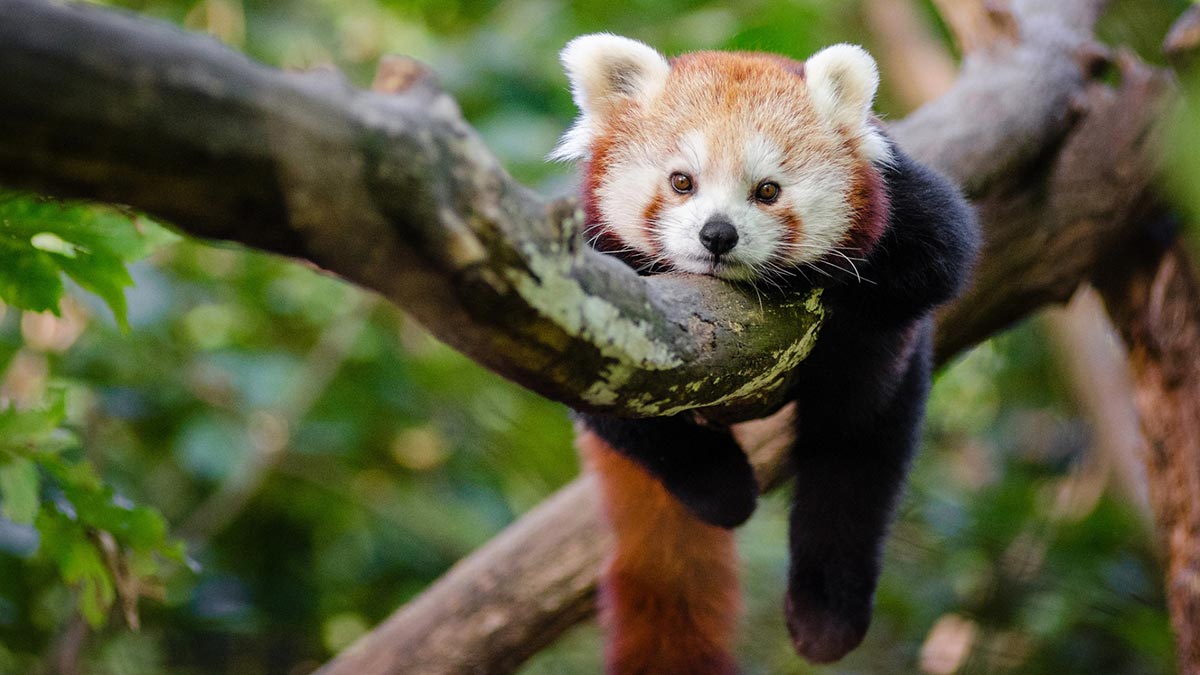
If you enjoyed this edition of Endangered Species you may be interested in my previous posts:
Content Sources
Kakapo Recovery, IUCN Red List, VetMed, Kakapo Description, Kakapo information

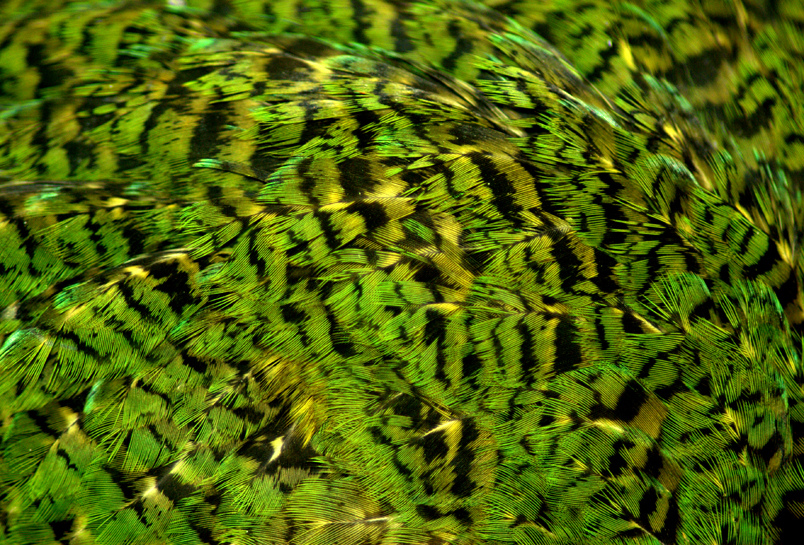
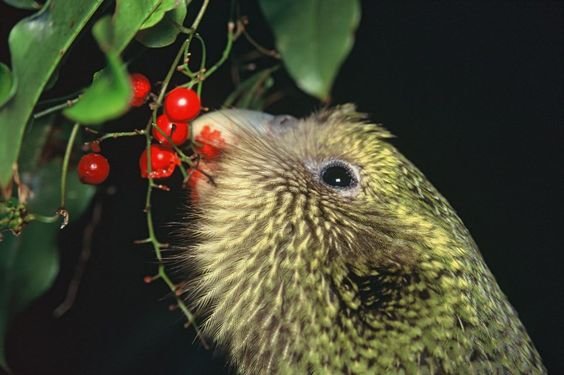
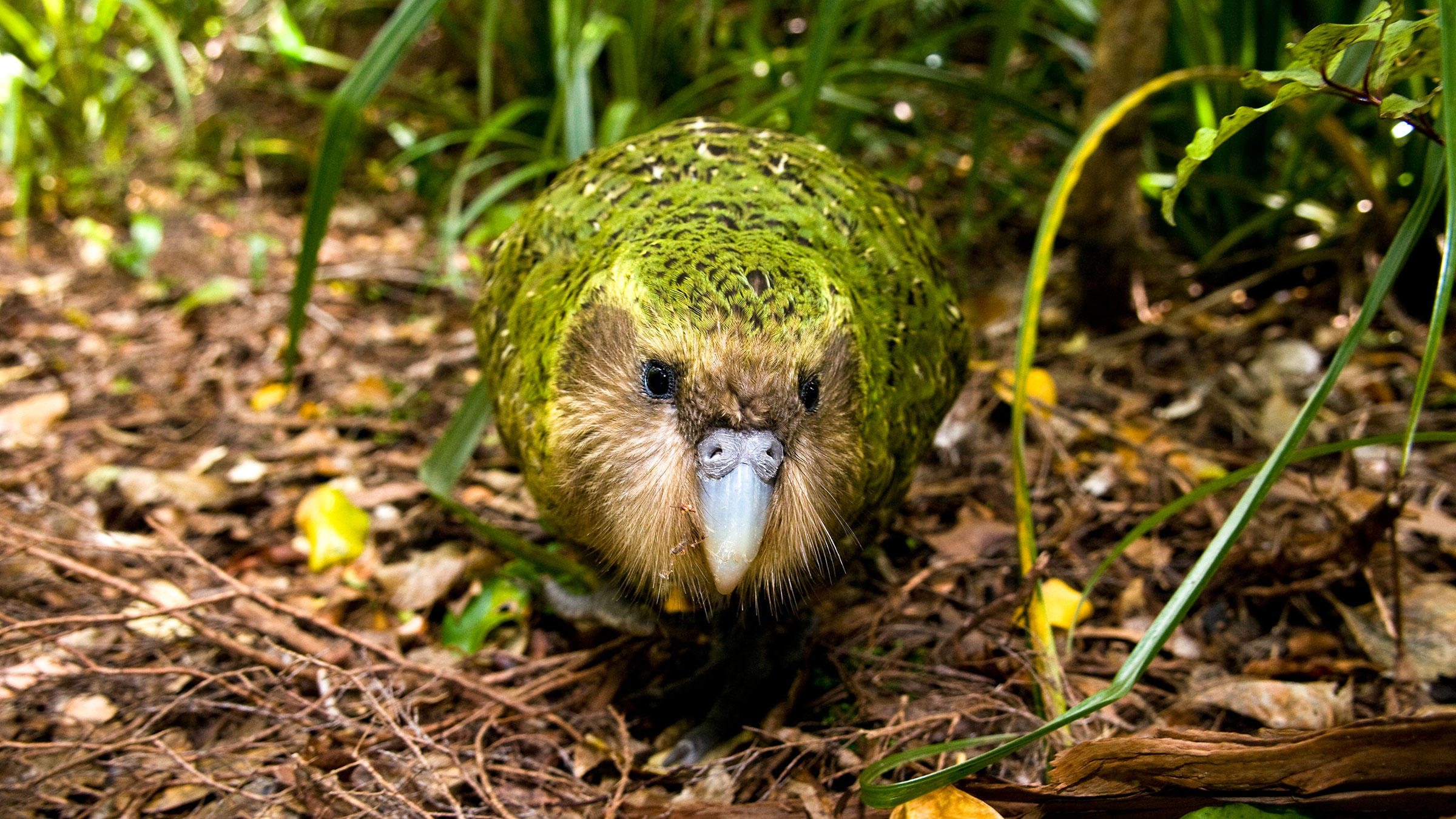
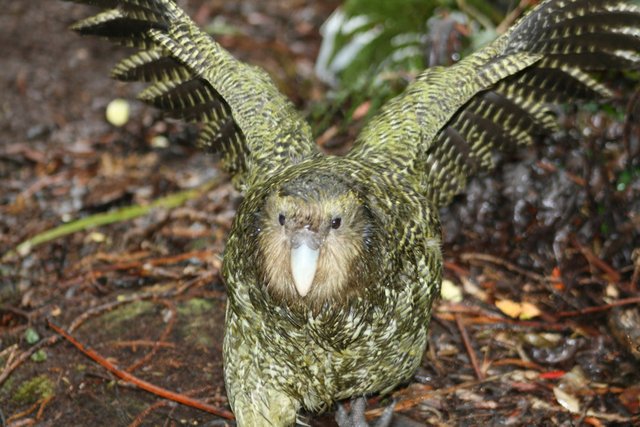

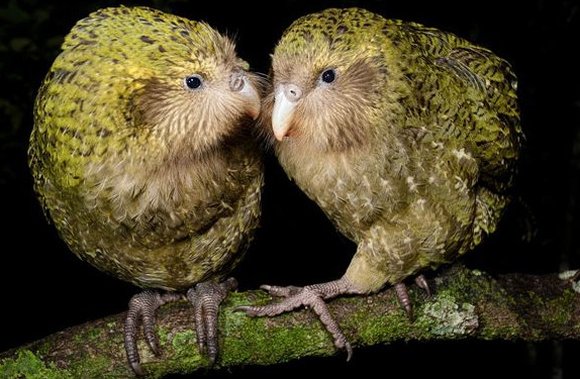
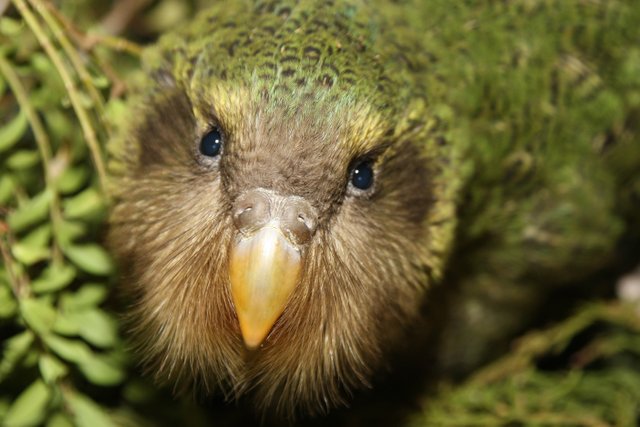
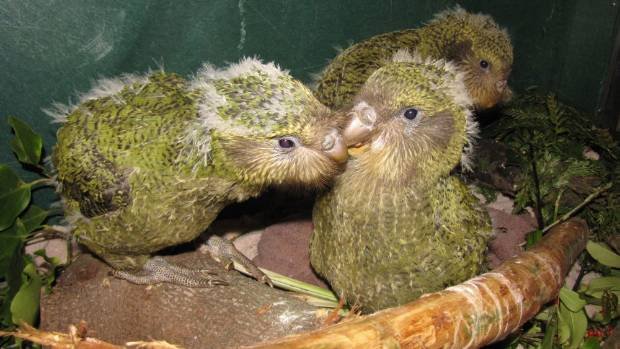
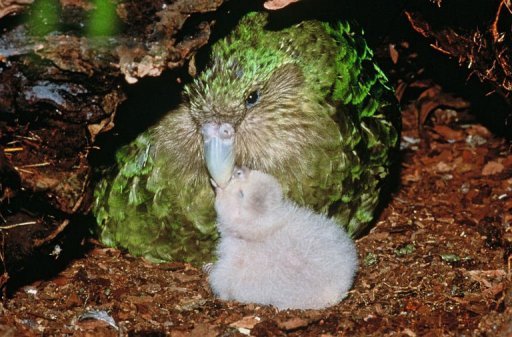
lol, did you ever see the famous Stephen Fry clip, filmed while he was here in NZ a few years ago?
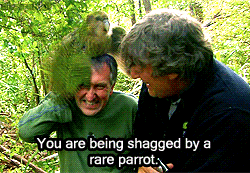
These parrots are indeed worthy of saving, and I think the team has done a wonderful job so far.
Thanks for including them in your list, amavi <3
Downvoting a post can decrease pending rewards and make it less visible. Common reasons:
Submit
Yes! I was going to include it in my post but decided to not go silly with it. So I am glad someone else did haha :D Great animal to feature eh? Love this little crazy parrot!
Downvoting a post can decrease pending rewards and make it less visible. Common reasons:
Submit
Such a thorough & outstanding article ♦♦ Glorious.
I thank you profusely ♦♦ Good way to start my day - by #reading about an unusual #animal.
I've always liked parrots -- the film called "Parrots of Telegraph Hill" is a favorite of mine (Filmed in San Francisco ). Did any of you (animal lovers) SEE that movie?
It was truly heartfelt, the way this man decided to TAKE in the Injured ones of the group of Parrots who lived in the trees outside his flat..
What I found of interest (in particular) was in observing the PARROT'S facial expression, I could (by the End of the movie) understand the emotion of the bird . Cool,huh?
Downvoting a post can decrease pending rewards and make it less visible. Common reasons:
Submit
I actually don't think I have seen that movie but I certainly will check it out. I am glad you enjoyed this weeks instalment! More to come :)
Downvoting a post can decrease pending rewards and make it less visible. Common reasons:
Submit
It's exact title = Wild Parrots of Telegraph Hill
Check it out, & will WATCH For more #Animal posts fm you.
Downvoting a post can decrease pending rewards and make it less visible. Common reasons:
Submit
That's a beautiful sun conure... Yours?
Downvoting a post can decrease pending rewards and make it less visible. Common reasons:
Submit
Kakapo? Really never heard of them. But they seem to an interesting flightless bird. Thanks to the conservation strategy by humans, this animals may not go extinct. Thank you for this very interesting post.
Downvoting a post can decrease pending rewards and make it less visible. Common reasons:
Submit
Your Welcome :) they are super interesting creatures that I’m glad I could feature on my blog
Downvoting a post can decrease pending rewards and make it less visible. Common reasons:
Submit
YES! You seriously pick the best animals to feature. I love these awkward guys. I unsurprisingly haven't seen any Kakapo in person, but the exhibit on them in the Te Papa museum was great. They had a special hat that was designed to collect samples from a captive Kakapo who liked trying to mate with people's heads... Sounds like their breeding program is having more success now!
Downvoting a post can decrease pending rewards and make it less visible. Common reasons:
Submit
Thats incredible that you got to see that, hopefully one day you will see them in person! They are certainly on my bucket list of animals to see. Yeah hopefully the breeding program will save this amazing little parrot!
Downvoting a post can decrease pending rewards and make it less visible. Common reasons:
Submit
There is nothing beautiful than nature
Downvoting a post can decrease pending rewards and make it less visible. Common reasons:
Submit
Couldn't agree more
Downvoting a post can decrease pending rewards and make it less visible. Common reasons:
Submit
Very informative article... Your commitment to kakapo conservation is obvious... Mother nature needs more people like you...
Downvoting a post can decrease pending rewards and make it less visible. Common reasons:
Submit
Well done! This post has received a 16.67 % upvote from @litasio thanks to: @steemstem-bot. Whoop!
If you would like to delegate to the @LitasIO you can do so by clicking on the following link: 10SP
Downvoting a post can decrease pending rewards and make it less visible. Common reasons:
Submit
@originalworks
Downvoting a post can decrease pending rewards and make it less visible. Common reasons:
Submit
@originalworks2
Downvoting a post can decrease pending rewards and make it less visible. Common reasons:
Submit
The @OriginalWorks bot has determined this post by @amavi to be original material and upvoted it!
To call @OriginalWorks, simply reply to any post with @originalworks or !originalworks in your message!
Downvoting a post can decrease pending rewards and make it less visible. Common reasons:
Submit
cute bird!
Downvoting a post can decrease pending rewards and make it less visible. Common reasons:
Submit
beautiful pictures with detailed explanation. @amavi
Downvoting a post can decrease pending rewards and make it less visible. Common reasons:
Submit
Thank you, I only wish these photos were my own. Perhaps one day I will get that opportunity
Downvoting a post can decrease pending rewards and make it less visible. Common reasons:
Submit
This post has received a 0.18 % upvote from @drotto thanks to: @steemstem-bot.
Downvoting a post can decrease pending rewards and make it less visible. Common reasons:
Submit
I love these wonderful birds and thought there was already a lot being done to try and protect them since they have been endangered for a while. Have you worked with one in the zoo or seen one in the wild before? I think the male bird's lifestyle would be quite good but unfortunately I am not good on the dance floor :D
Downvoting a post can decrease pending rewards and make it less visible. Common reasons:
Submit
Hi @amavi, I have nominated you for an award because I think your posts are great: https://steemit.com/contest/@trophy-token/classy-content-nominations-2-win-a-trophy
Downvoting a post can decrease pending rewards and make it less visible. Common reasons:
Submit
wow, thank you!
Downvoting a post can decrease pending rewards and make it less visible. Common reasons:
Submit
Downvoting a post can decrease pending rewards and make it less visible. Common reasons:
Submit
it's the first time i hear about this parrot, i wish they will save them, thank you for the interresting informations
Downvoting a post can decrease pending rewards and make it less visible. Common reasons:
Submit
Hopefully we can save them! Only time will tell!
Downvoting a post can decrease pending rewards and make it less visible. Common reasons:
Submit